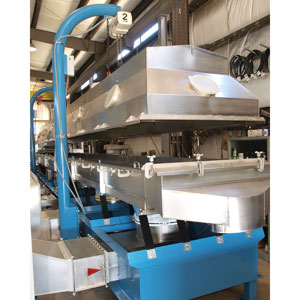Difference between revisions of "Vibrating Fluid Bed Coolers"
Jump to navigation
Jump to search
| Line 13: | Line 13: | ||
== | ==Applications== | ||
* Processing of material that has a wide particle size distribution. Vibration will help to discharge oversize particles that will not fluidize. | * Processing of material that has a wide particle size distribution. Vibration will help to discharge oversize particles that will not fluidize. | ||
* Processing of sluggish or sticky materials. | * Processing of sluggish or sticky materials. | ||
* Processing of fragile materials. Low amplitude vibration and reduced fluidizing velocity create a gentle bed, which causes less degradation than conventional fluid beds or other mechanical coolers. | * Processing of fragile materials. Low amplitude vibration and reduced fluidizing velocity create a gentle bed, which causes less degradation than conventional fluid beds or other mechanical coolers. | ||
Latest revision as of 22:04, 4 August 2012
Vibrating Fluid Bed Coolers are used to cool a variety of products at a wide variation of feed rates.Vibrating fluid bed coolers function by passing a process gas directly through a bed of solids via a perforated plate or another type of fluidizing media. Vibration is added to aid in fluidization of more difficult to fluidize materials.
Applications
- Processing of material that has a wide particle size distribution. Vibration will help to discharge oversize particles that will not fluidize.
- Processing of sluggish or sticky materials.
- Processing of fragile materials. Low amplitude vibration and reduced fluidizing velocity create a gentle bed, which causes less degradation than conventional fluid beds or other mechanical coolers.

